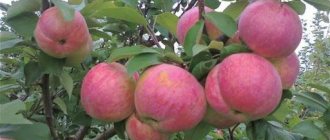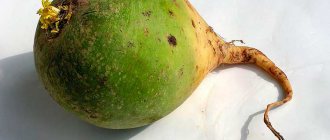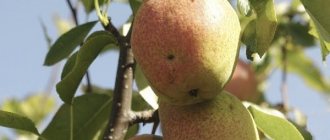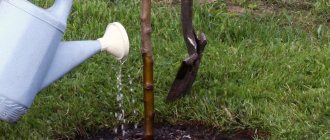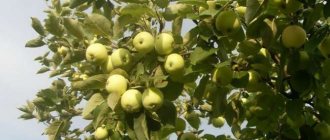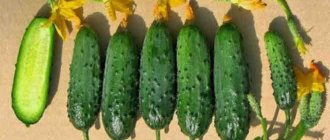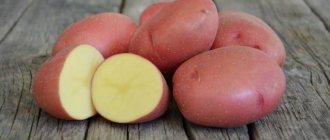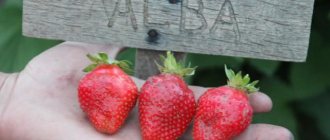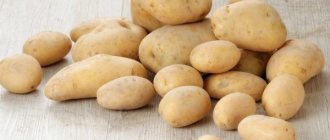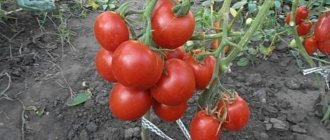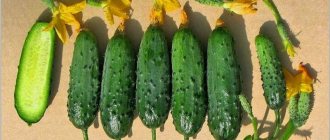Botanical description of the variety
The trees of this variety are tall - 6-7 m. The crown is powerful, pyramidal in shape. Branching of sympodial type. This means that the upper axillary bud forms a second-order axis, which in the direction of growth is located similar to the first-order axis, gradually displacing its dying section. The shoots are smooth, without thorns. Vegetative shoots are colored red-brown, generative shoots are much darker.
Did you know? Malic acid is used in the production of teeth whitening products.
The ellipsoidal leaves are attached to the shoots using long petioles. The color of the leaves is green or yellowish-green. In young specimens, the leaf blades are heavily pubescent; in adults, the down is less or completely absent. Flowering is abundant. Flowers are arranged singly or in inflorescences of 2–5 pieces. They are initially painted pink, then change it to light pink or white.
The fruits are small-sized. 100–120 g in weight, roundly flattened. The peel is yellow-green with many red-pink stripes. The surface of apples is shiny, smooth, with a thin layer of natural coating wax. The cut flesh is white, soft, and very juicy. Exudes a pleasant aroma. The taste is sweet and sour, refreshing. The plant bears fruit in a year. It is a self-sterile species and therefore requires pollinators.
Reviews
Valeria, Kazan
Grushovka has been growing in our garden for as long as I can remember. Apples ripen in late July. They have a wonderful taste, juicy, sweet, aromatic. Apples are pleasant to eat, they are not iron and the skin is not particularly noticeable. The only drawback is that it bears fruit after a year. Therefore, we dry and cook compotes with a reserve of two years. The productivity of the apple tree allows this to be done; it is even enough for sale. Sometimes green aphids attack, we don’t spray it with chemicals, we deal with it using folk remedies.
Elena, Tver region
An ancient Russian variety, in our gardening partnership there is no area where this apple tree does not grow. Our tree is about 15 years old, it produces harvests every other year, but they are very abundant. Does not require special care. We cut off old branches in the fall and whiten the trunks with lime. In early spring and late autumn, we spread manure and a little dry superphosphate under the apple tree. The apples ripen gradually, so we have time to eat and process everything. I cut some apples and freeze them, and in winter we bake fragrant sweet pies.
How is it different from other varieties?
The Grushovka apple tree differs from other varieties primarily in its super-high winter hardiness. Few plants can tolerate frost of -50°C and are then able to produce a full harvest. The second difference is the long life cycle of the plant, which is 50–60 years, while most trees live on average 30–40 years.
Did you know? Popular singer Justin Timberlake hired an entire company to calculate the amount of carbon dioxide emitted during his concerts. As soon as the singer received the result, he immediately began planting trees in every locality where he performs to compensate for the expended amount of oxygen.
Advantages and disadvantages
- The main advantages of Grushovka:
- winter hardiness and ability to quickly recover from frost;
- long lifespan;
- high yield.
- Among the disadvantages of the variety it should be noted:
- irregular fruiting - bears fruit once every 2 years;
- uneven ripening of the crop - the apples ripen gradually, and not all at once, and if you do not have time to remove the ripened ones, they will crumble;
- the need to plant pollinator plants nearby;
- short shelf life of fruits.
Existing varieties
As a result of selection, two varieties of the variety were obtained.
Winter
This variety appeared as a result of crossing the Moscow Grushovka and the French Kroncel variety. The fruits of the resulting variety are large, and the variety itself is very prolific .
The disadvantages of the variety include poor frost resistance and susceptibility to disease.
Early
A very successful variety obtained by crossing Grushovka Moskovskaya and Bely Naliv. The fruits of the resulting variety are large in size and high in yield.
Unlike Winter Grushovka, Early is resistant to diseases , and even scab is not scary for her. In addition, the variety tolerates frost well. However, there are also some disadvantages, including the cyclical nature of fruiting, and the fruits themselves do not appear soon.
You can learn more about early pear harvesting from the video:
Features of planting and growing
The area for the Grushovka apple tree needs to be spacious, well lit from all sides, and at the same time protected from drafts. Plants develop best on sandy, loamy and turf soils with a neutral pH level, in the range of 5–7.5. For this variety, the main roots lie very deep, so the distance to groundwater should be at least 3 m.
When the site has been selected, you can take care of purchasing planting material. When choosing a seedling, you should first of all pay attention to its age - the younger it is, the better and faster it will take root in a new place. The most suitable option is a 1-2 year old plant.
You can determine the age of a seedling yourself:
- one-year-old plants do not have skeletal branches, and their height does not exceed 1.2 m;
- two-year-olds already have skeletal branches located at an angle of 45–90°, and the height of the trunk is 1.5 m.
Having determined the age, you need to move on to examining the trunk itself and the root system.
The stem of the plant should be smooth, without flaws or damage. The coloring throughout the trunk of a healthy specimen is uniform. The stem itself is elastic, not dry, and easily bends to the sides without making a crack. The rhizome should also be uniformly colored light gray. It is worth paying attention to the number of roots - there should be several main roots, tap roots and many additional ones. Did you know? Rings on the cut of a tree, which make it possible to determine its age, are formed only when the seasons change,
as a result of changes in the rate of development of plant tissues.
In the tropics, not a single tree has such rings, because there are no sudden temperature changes there. The underground part should not be overdried or show signs of rot. Planting can be done in late April - early May or in September - October. In any case, you need to start preparing the soil on the site in advance. It is better to start doing this six months before planting. First you need to clear the area, uproot old plants, and cultivate to a depth of 30 cm.
After this, water the soil with a 3% solution of copper sulfate. A week later, you should dig up the soil again, after adding 10 kg of sand to each m² (if the soil is sandy or sandy loam, this is not necessary), 10 kg of peat, 20 kg of fresh manure and 500 g of superphosphate.
A month before planting, cultivation must be carried out again, after adding 20 kg of compost and 800 g of wood ash to each m². 7–10 days before planting, dig a hole: hole depth 60 cm, width 100 cm. Half of the soil from the hole should be mixed with 25 kg of compost and 200 nitrophoska added. Drive a stake into the center of the hole and fill it 1/3 in layers with clean and fertilized soil. After these manipulations, pour 20 liters of warm (+30°C) water into the hole.
We recommend that you learn how to get rid of rotting apples.
Planting is carried out as follows:
- A mound is made in the center of the pit.
- Place the roots of the seedling in the hole and straighten them.
- Cover the rhizome with soil, alternating layers of fertile and clean soil.
- The trunk circle is compacted.
- Pour in 30 liters of water.
- The next day, loosen the soil around the tree and mulch it with compost.
Proper planting of an apple tree: 1 - placing the seedling in a trench; 2 - seedling buried for the winter.
Subtleties of care
In order for the tree to develop well, it will need some care. The first year of the plant’s life on the site, watering is carried out once a week, adding 20 liters at a time. From the second year, they switch to watering mode once a month, adding 40–60 liters at a time, depending on weather conditions. Watering is stopped completely 3 weeks before the expected harvest. After each watering, the soil in the tree trunk circle must be loosened, simultaneously getting rid of weeds, and then mulched.
Important! If you regularly ration the crop by removing the central fruits from the bunches at the time of ovary formation or using other methods that involve spraying with various compounds, then it is quite possible to achieve annual fruiting.
As mulch during the warm season, you can use sawdust 1:1 mixed with peat or sand. When the plant blooms for the first time, 85% of the flowers should be removed. After setting the fruits, remove half of them. If this is not done in the future, the tree will develop poorly, which will negatively affect the quality and quantity of the harvest.
From the age of two, plants begin to be fed annually according to the following scheme:
- before the buds swell - for each m², 8–12 kg of rotted manure or 400–600 g of urea (apply fertilizers into the soil to a depth of 5 cm or dilute in 30 liters of water);
- in June - add 30 g of superphosphate and potassium sulfate to 30 liters of water;
- after harvesting - 30–40 g of Kemira autumn fertilizer.
Pruning is carried out annually.
They begin manipulations the next year after planting. The central conductor is shortened by 30 cm, the side skeletal branches - by 1/3 of the length. No more than 5 skeletal branches of the first order are left on the trunk. In subsequent years, 2 branches are left on each of the skeleton conductors, the rest are cut out. Regulation of growth force and crown formation allows you to cope with the frequency of fruiting. Find out who the codling moth is.
In the future, the third tier can be formed in a similar way. When the crown is formed, sanitary pruning is performed in spring and autumn. Such manipulations involve the removal of conductors competing with the main, damaged and growing branches inside the crown. All trimming is carried out with a well-sharpened tool. After such work, all wound surfaces are treated with a 1% solution of copper sulfate or crushed activated carbon, and then sealed with garden varnish.
Apple tree pruning diagram. In autumn, the tree trunk circle is carefully loosened, the plant and soil are sprayed with Fitosporin according to the instructions. Then mulch the soil with rotted manure. The mulch layer should be at least 10 cm. After tilling the soil, the plant trunk must be whitened to a height of 1 m. For young trees (up to 3 years old), the trunk is wrapped in burlap.
Varietal apple tree Moscow pear
Undoubtedly, everyone has heard about this variety - the Grushovka apple tree. This is an “old-time” Russian variety and was first depicted in the Gardening magazine by the famous scientist Andrei Bolotov.
This variety has been famous in Russia since the mid-17th century . It is zoned mainly in the Non-Black Earth Region, in the Middle and Southern Urals and in the Siberian region . A description and photo of the apple tree will be given in this article below.
Tree height and crown width
Apple trees always grow into powerful trees , sometimes reaching 7 meters in . At first the crown is cone-shaped, but with age, due to large harvests, the crown changes from cone-shaped to spreading, and after some time it becomes completely round.
Beginning of fruiting
- An apple tree of this variety begins to bear fruit 4-6 years after planting if it is grafted onto dwarf and semi-dwarf rootstocks.
- When grafted into a wild or vigorous apple tree, the first harvest occurs only after 6-8 years .
Shape and weight of apples and their color
The fruits of this variety are small, weighing on average 84-111 grams, with a maximum of 127 grams . The shape of apples is flattened, rounded-flat, turnip-shaped. When fully ripe, the skin is lemon-yellow with stripes and carmine-orange in color. The pulp is straw-yellow.
Moscow pear pulp.
Taste, aroma and tasting score
The taste of ripened apples is full, harmonious, honeyed, refreshing . The aroma is weak , and when stored for 10 days it intensifies slightly. Note that Grushovka apples do not have a pear taste at all. Taster rating 4.4-4.6 on a 5-point scale .
Ripening period
Apples ripen early - around the first ten days of August.
Spur mutants with a later ripening period are possible.
This is how the “autumn” and “winter” form types of Grushovka became widespread.
Winter hardiness
One of the primary advantages of Grushovka is its highest cold resistance. It is explained by the fact that the variety was obtained from wild apple trees and retained all the advantages obtained as a result of natural selection. That is why apple trees can withstand cold temperatures down to -50ºС.
IMPORTANT! Only properly fed and pruned trees will survive harsh winters!
Diseases
most often destroy Grushovka trees :
- scab;
- moniliosis;
- black cancer
It is also necessary to combat fungal diseases and wood-destroying fungi . They are dangerous, especially for aging and old Moscow Grushovka apple trees.
Disease resistance
The variety is not resistant to the most common fungal diseases, such as scab and moniliosis .
Trees have to be treated with fungicide solutions.
Resistance to scab is very weak, and sometimes completely absent. Therefore, constant treatment with remedies for this disease is required.
ADVICE! Do not use chemicals “for prevention”!
Watch the video on how to fight Pasha on an apple tree:
Pollinator varieties
This variety belongs to self-sterile apple trees . That is, it needs other varieties that grow nearby and bloom at the same time as this variety. Good as pollinators:
- Antonovka;
- Candy;
- Striped anise;
- Chinese;
- White filling.
Antonovka.
Candy.
Striped anise.
Chinese Crab.
White filling.
In this video you can see a detailed description of the Moscow pear tree:
Semi-dwarf
The semi-dwarf Grushovka can only be grafted. It is of little interest except for sellers, since the fusion bursts in the 15-17th year. It is not recommended by professionals for industrial planting of gardens.
Dwarf
With a dwarf rootstock, especially a vegetatively propagated one, the situation is even worse.
Due to the multiple fruits on the side of the Grushovka scion and poor splicing on the side of the rootstock and without proper supports, such trees often split completely or in half.
Therefore, it is risky to establish large plantations.
Columnar
Information is being spread on the Internet that there is such a columnar type. They say that it is characterized by increased cold resistance, the apples are small, lemon-colored with a slight rosy cheek, and have a sour taste.
Late
This is another promotion . Since in the Leningrad region, due to the short summer, such an apple tree actually produces apples, like an ordinary late-autumn apple tree of any other variety. But there is nothing new in it.
Summer
This is a typical "synomic" variety name . This is how Grushovka is sold in the southern regions. And due to the peculiarities of its development, it cannot grow normally there, which is why sellers resort to various tricks.
Grushovka, grown in the southern regions.
The soil
A hole for planting is dug 1 m by 1 m. The soils most suitable for this apple tree are sandy loams
and
loams , with a close to neutral reaction, rich in organic matter and microelements.
Landing technology
- Planting is carried out by two people;
- A support peg is required;
- The landing site is protected from the winds and is not located in a lowland;
- Also, groundwater should not come closer than one and a half meters to the surface.
Watch the video instructions on how to plant an apple tree correctly:
Possible pests and diseases
The culture is not resistant to fungal and bacterial diseases. When bacterial diseases appear, plants cannot be treated. They are uprooted and burned.
Important! When carrying out preventive and therapeutic measures, do not forget that insecticides and fungicides of the same type can only be used throughout the year. Next season, treatment preparations should be changed, otherwise harmful microorganisms and parasites will adapt to them, which will make all measures ineffective.
The most typical fungal diseases for Grushovka are:
- Clusterosporiosis;
- moniliosis;
- fusarium;
- scab.
When they appear, the first step is to remove all infected areas. They are treated with copper sulfate and covered with garden pitch. Then spray with fungicidal agents. You can use the drug "SWITCH". Add 2 g of substance per 10 liters. The product is effective against the vast majority of fungal spores of different strains.
1 - klyasterosporiosis; 2 - moniliosis; 3 - scab. Among the pests that are dangerous for the apple tree of the variety in question are:
- aphids - you can eliminate them by spraying plants with a solution of wood ash (800 g of ash per 10 water);
- leaf roller - eliminated by dusting with tobacco dust;
- mite - treatment with a 1% solution of copper oxychloride will help to cope with it.
Origin story
This variety was bred in 1957 by the famous breeder S. F. Chernenko. The variety was obtained by crossing Kronselsky transparent and Moscow Grushovka. The variety is not widely used due to low winter hardiness and susceptibility to disease.
But, thanks to its good yield and keeping quality, it also has the right to exist in personal plots.
The hand of the same breeder belongs to Renet Chernenko, Iyulsky Chernenko, Kandil Orlovsky, Anis Aly and Altai Bagryanaya.
